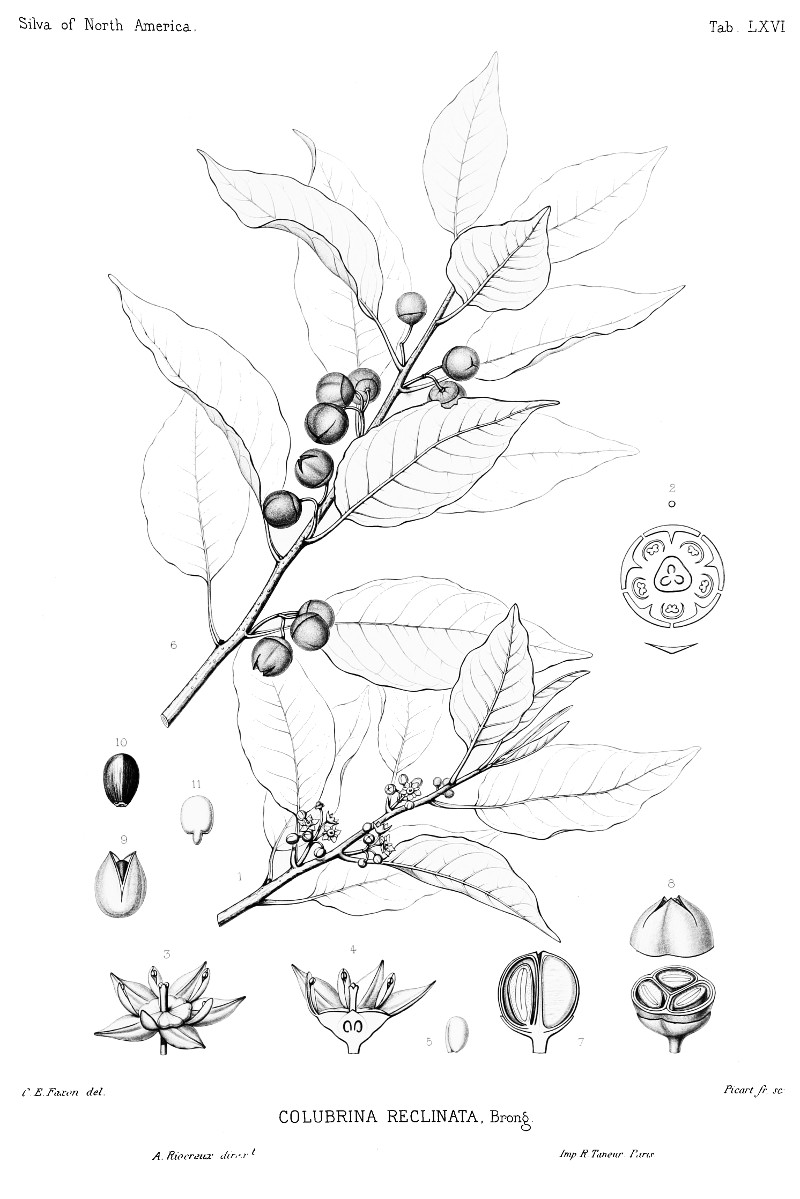Colubrina elliptica (Sw.) Brizicky & W. L. Stern - syn.Colubrina reclinata (L’Hér.) Brongn.; Rhamnus elliptica Sw. - Rhamnaceae
mabi, bois mabi, soldierwood
Evergreen shrub or small tree, up to 5m tall, native to the Caribbean; bark orange-brown, fissured, splitting off in thin scales, inner bark light brown, bitter; leaves alternate, entire, elliptic-ovate, short-pointed at apex and rounded at base; flower sepals green, petals yellow.
The bark contains bitter triterpene saponins, called mabiosides A-C, 3-O-[α-JL-rhamnopyranosy]-(1→6)-β-D-glucopyranosyl-15-O-[β-D- glucopyranosyl] mabiogenin, 3-O-[α-L-rhamnopyranosy]-(1→6)-[β-D-glucopyranosyl-(1→62]-β-D-glucopyranosyl] mabiogenin and 3-O-[α-L-rhamnopyranosyl-(1→6)-β-D-glucopyranosyl] mabiogenin.
[New bitter saponins from the bark of Colubrina elliptica: 1H and 13C assignments by 2D NMR spectroscopy., Tinto, W.F., Reynolds, W.F., Seaforth, C.E., Mohammed, S., Maxwell, A., Magnetic resonance in chemistry, 31(9), 1993, 859-864]
„The bark from both C.arborescens and the sister species C.elliptica are used to make the popular refreshing
beverage called mabi, or mauby, or mawbie. The unsweetened decoction of the bark also is taken as a bitter tonic and even to treat diabetes… As a fermented drink from C.elliptica bark, mabi is prepared by the joint actions of microorganisms occurring in the unrefined sugar used, and the inoculant or starter, called the „pie“. Preservation of the fermented mabi drink is achieved by pasteurization with added sodium benzoate, and this improves its attributes for commercial production… Important constituents of the bark of C.elliptica
are a mixture of bitter-tasting saponins (triterpenoid glycosides), as well as condensed tannins (0.15%) which contribute to the astringency (body and fullness of flavour) to the special taste of mabi drinks. Alkaloids (scutianine and its derivative compounds) occurring in the bark make only minor contributions.“
[Seaforth, C., Tikasingh, T., Gupta, M., St Rose, G., A study for the development of a handbook of selected Caribbean herbs for industry, 2008, 28-30] https://cgspace.cgiar.org/bitstream/handle/10568/63637/010905_Caribbean_Herbs_final_repor.pdf?sequence=1
„At its most basic level, the mauby is simply an unsweetened bark decoction, though most batches include several ingredients to enhance the bark’s rich flavor and to release aromatic vapors. A fairly generic mauby recipe consists of boiling the mauby bark, cinnamon and allspice sticks, and a couple bay leaves for thirty minutes. The bark, sticks, and leaves are strained, and the decoction is allowed to cool. Next, a simple syrup is prepared by boiling sugar and water, after which it is added to the unsweetened mauby bitters until the desired sweetness is obtained. The drink is refrigerated, or in some cases left uncovered for a few days to allow fermentation to occur. In the case of fermented mauby, a portion of the batch may be saved to act as a starter for the next batch… reduction in anxiety could be the “cooling of the blood” effect that Barbadians most commonly ascribe to mauby use. Consumers do not seem to consider the cooling effects of mauby to be medicinal, however, instead citing the treatment of diabetes mellitus as mauby’s most common medicinal use. The minute amounts of scientific research that have been conducted on mauby bark and diabetes mellitus, on the other hand, suggest that there is no relationship between the bark and the disease.“
[Maggiolo, C. A. (2010). Champagne Taste on a Mauby Pocket.] http://publish.wm.edu/cgi/viewcontent.cgi?article=1690&context=honorstheses

Colubrina elliptica as Colubrina reclinata
Sargent,C.S., The Silva of North America, vol.2 t.66 (1898) [C.E.Faxon]
http://plantgenera.org/species.php?id_species=264867